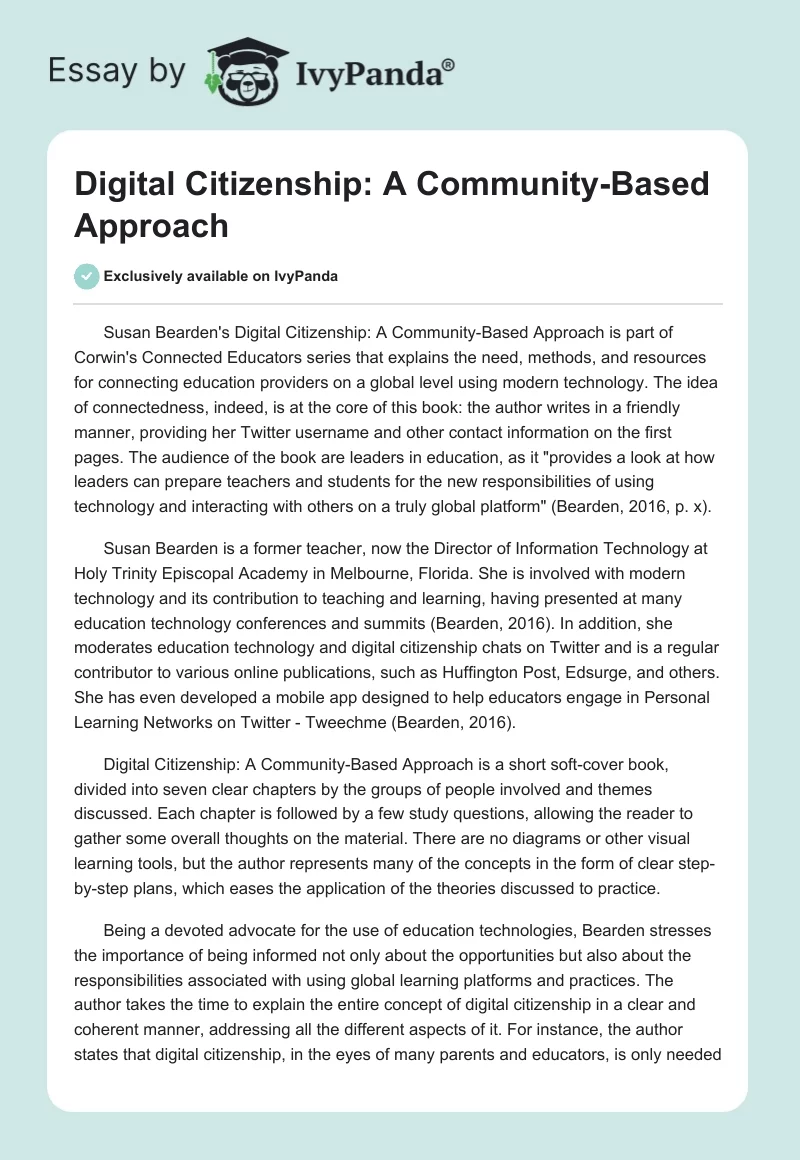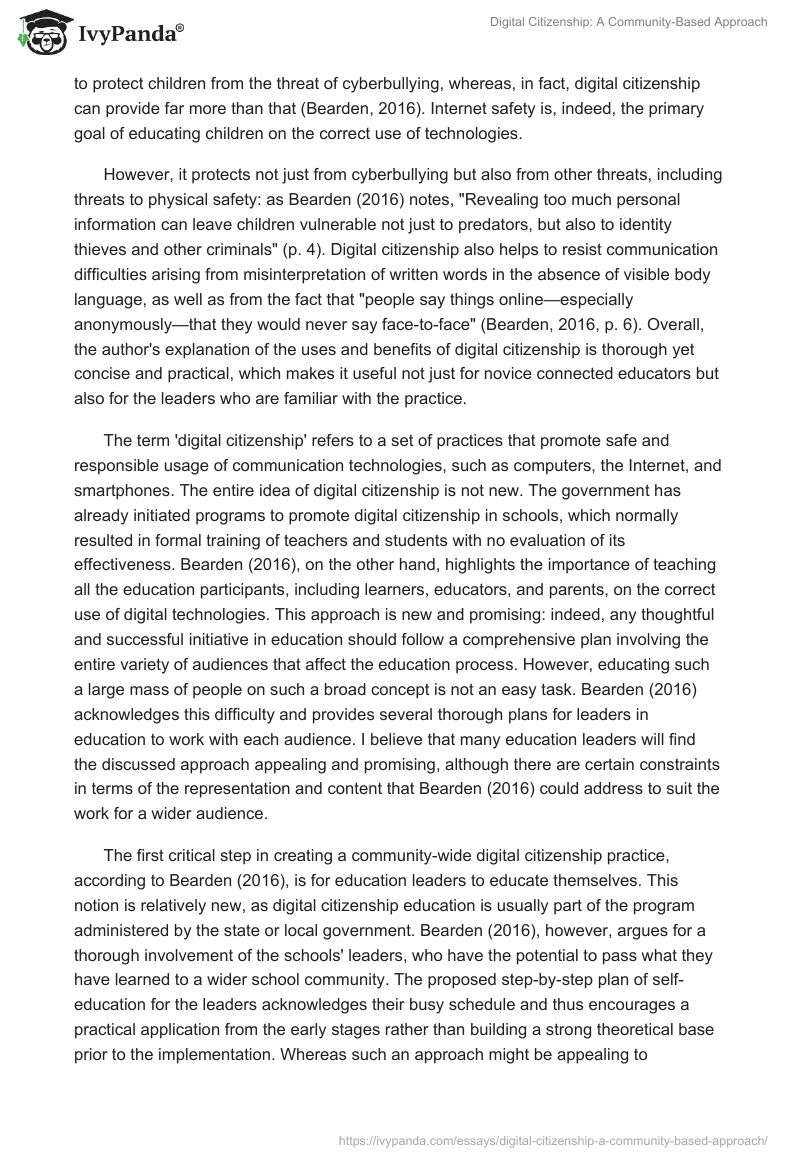Susan Bearden’s Digital Citizenship: A Community-Based Approach is part of Corwin’s Connected Educators series that explains the need, methods, and resources for connecting education providers on a global level using modern technology. The idea of connectedness, indeed, is at the core of this book: the author writes in a friendly manner, providing her Twitter username and other contact information on the first pages. The audience of the book are leaders in education, as it “provides a look at how leaders can prepare teachers and students for the new responsibilities of using technology and interacting with others on a truly global platform” (Bearden, 2016, p. x).
Susan Bearden is a former teacher, now the Director of Information Technology at Holy Trinity Episcopal Academy in Melbourne, Florida. She is involved with modern technology and its contribution to teaching and learning, having presented at many education technology conferences and summits (Bearden, 2016). In addition, she moderates education technology and digital citizenship chats on Twitter and is a regular contributor to various online publications, such as Huffington Post, Edsurge, and others. She has even developed a mobile app designed to help educators engage in Personal Learning Networks on Twitter – Tweechme (Bearden, 2016).
Digital Citizenship: A Community-Based Approach is a short soft-cover book, divided into seven clear chapters by the groups of people involved and themes discussed. Each chapter is followed by a few study questions, allowing the reader to gather some overall thoughts on the material. There are no diagrams or other visual learning tools, but the author represents many of the concepts in the form of clear step-by-step plans, which eases the application of the theories discussed to practice.
Being a devoted advocate for the use of education technologies, Bearden stresses the importance of being informed not only about the opportunities but also about the responsibilities associated with using global learning platforms and practices. The author takes the time to explain the entire concept of digital citizenship in a clear and coherent manner, addressing all the different aspects of it. For instance, the author states that digital citizenship, in the eyes of many parents and educators, is only needed to protect children from the threat of cyberbullying, whereas, in fact, digital citizenship can provide far more than that (Bearden, 2016). Internet safety is, indeed, the primary goal of educating children on the correct use of technologies.
However, it protects not just from cyberbullying but also from other threats, including threats to physical safety: as Bearden (2016) notes, “Revealing too much personal information can leave children vulnerable not just to predators, but also to identity thieves and other criminals” (p. 4). Digital citizenship also helps to resist communication difficulties arising from misinterpretation of written words in the absence of visible body language, as well as from the fact that “people say things online—especially anonymously—that they would never say face-to-face” (Bearden, 2016, p. 6). Overall, the author’s explanation of the uses and benefits of digital citizenship is thorough yet concise and practical, which makes it useful not just for novice connected educators but also for the leaders who are familiar with the practice.
The term ‘digital citizenship’ refers to a set of practices that promote safe and responsible usage of communication technologies, such as computers, the Internet, and smartphones. The entire idea of digital citizenship is not new. The government has already initiated programs to promote digital citizenship in schools, which normally resulted in formal training of teachers and students with no evaluation of its effectiveness. Bearden (2016), on the other hand, highlights the importance of teaching all the education participants, including learners, educators, and parents, on the correct use of digital technologies. This approach is new and promising: indeed, any thoughtful and successful initiative in education should follow a comprehensive plan involving the entire variety of audiences that affect the education process. However, educating such a large mass of people on such a broad concept is not an easy task. Bearden (2016) acknowledges this difficulty and provides several thorough plans for leaders in education to work with each audience. I believe that many education leaders will find the discussed approach appealing and promising, although there are certain constraints in terms of the representation and content that Bearden (2016) could address to suit the work for a wider audience.
The first critical step in creating a community-wide digital citizenship practice, according to Bearden (2016), is for education leaders to educate themselves. This notion is relatively new, as digital citizenship education is usually part of the program administered by the state or local government. Bearden (2016), however, argues for a thorough involvement of the schools’ leaders, who have the potential to pass what they have learned to a wider school community. The proposed step-by-step plan of self-education for the leaders acknowledges their busy schedule and thus encourages a practical application from the early stages rather than building a strong theoretical base prior to the implementation. Whereas such an approach might be appealing to education leaders due to their lack of time for extensive reading and learning, it seems a little unrealistic for a leader to be able to promote digital citizenship across the community while spending no more than fifteen minutes on reading about it each day. Bearden (2016) creates an impression that the core principle of the promotion of digital citizenship education by the leaders in creating awareness about it, but it is hardly possible to expect the teachers to want to learn more about the concept if your own knowledge on the subject is scarce.
Nevertheless, the author believes that a self-educated leader would be able to successfully initiate a digital citizenship training program for teachers and faculty members. Training the entire school staff allows them to avoid information security risks that could affect the reputation of the school in a negative way (Bearden, 2016). Thus, the author creates a practical aim that answers the needs of school leaders and creates more motivation for them to implement the practice of digital citizenship education at their school. The proposed plan of staff and faculty training is thorough and adequate, addressing the various aspects of digital citizenship that apply to teachers.
For instance, the author discusses the correct usage of copyrighted material in great detail, which is important, as it can help school leaders to avoid the breaking of copyright laws that might lead to a lawsuit against the entire school. Bearden also addresses the use of digital learning platforms and communication with students, which is crucial to establish the rules and norms of teacher-student online communication to avoid misinterpretation and preserve authority in the classroom. However, even though the author argues for the use of separate profiles for the teachers’ professional and personal communication, no explanations are provided as to why this is crucial. The teenagers’ tendency to be more open in internet communication and to perceive it as a way to build a personal connection to the teacher needs to be addressed for the staff to understand the importance of setting borders when it comes to social media and e-mail correspondence with students of this age.
Another innovation proposed by Bearden (2016) is the incorporation of digital citizenship education into all lessons rather than approaching it as a separate discipline. Again, the author provides no substantial reason as to why this is the preferred method, moving on to explain the various tools that could be used by teachers instead. Concentrating on the practical implications of the approach instead of providing a sound basis for utilizing it is, perhaps, the main weakness of the book. Clearly, there is no unified approach that teachers all over the world would use to incorporate digital citizenship education in their classes, which is why it would be useful to devote more attention to the theoretical basis of the approach rather than to its step-by-step implementation.
Finally, the involvement of parents in the digital citizenship education process is a significant proposition. Few writers who discuss the notion of digital citizenship refer to the importance of engaging the parents in the approach, which adds novelty to Bearden’s theory. The author clearly identifies the challenges and opportunities of the parents’ engagement, outlining the processes to maximize the effectiveness of the program. Another prominent suggestion is Bearden’s (2016) proposition to start educating parents on digital citizenship before the start of middle school: “The proliferation of mobile devices means that children are accessing the Internet at increasingly younger ages” (p. 47). This is an interesting approach, as it highlights the importance of changing the digital citizenship education strategies in accordance with the advancements in the field of digital technology use.
There are many strengths to the approach proposed in Bearden’s book: for instance, the involvement of the entire community might indeed help to ensure that the students use digital technologies correctly, as well as to avoid the misuse of data and social media by teachers, which could lead to a lawsuit against the school. Bearden (2016) also provides many external resources for further reading to show the audience where to start the self-education process. The primary weakness of the book, however, is that the author relies on the readers’ teaching experience to find explanations for most of the statements instead of supporting the theories discussed with evidence.
Moreover, even though the fact that the author writes for the leaders in education is logical, the author’s style and the structure of the work make it almost useless for other professionals, such as teachers. For instance, Bearden discusses all implementation strategies from the leader’s point of view. Furthermore, the author does not explain the benefits of digital citizenship for regular teachers and students, only listing the advantages of the strategy for the school and its management. I believe that a more flexible approach to discussing the subject could make the book valuable to a wider audience. For example, Bearden could have noted that the correct understanding of digital citizenship will help students in further life and work, as more and more tasks require the use of the Internet. Also, it would be helpful to discuss the strategies that teachers could use in the classroom, in addition to the school-wide approaches.
Overall, Digital Citizenship: A Community-Based Approach by Susan Bearden provides a clear guide for education leaders on how to implement the community-based approach to digital citizenship education in their learning institutions. The book only contains the necessary functional information, which makes it a useful tool for education leaders worldwide who are already familiar with the core concepts and theory behind the approach and want to learn more about its practical implementation.


